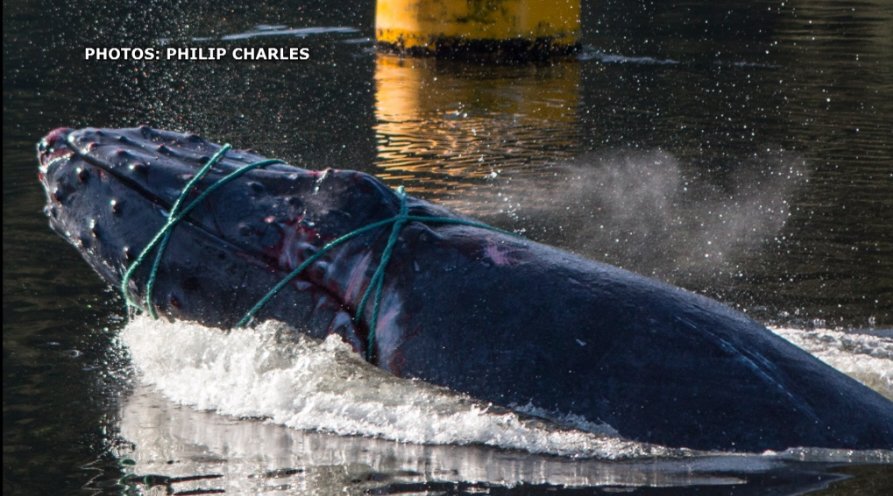Wildlife interactions with open-pen salmon farms
Open-pen salmon farms attract, trap, drown and otherwise harm wildlife in many ways
Overview
-
● “Endangered species like humpback whales, orcas, sea otters, endemic Chilean dolphin, cold water corals, albatross, penguins are all threatened by salmon farms.”
Alan Friedlander, researcher and science director of the Pristine Seas programme
● “The potential impacts of [fish] farms including habitat exclusion, entanglement, entrapment, collisions, and behavioural modifications are the primary risks posed to protected species by marine aquaculture facilities and operations.”
A global review of protected species interactions with marine aquaculture (peer-reviewed)
● “Marine mammalian predators, such as seals (pinnipeds) and dolphins (cetaceans) are often attracted to aquaculture facilities because of the concentration of fish within the nets, but also the higher population density of wild fish species that are attracted by the net structure and excess food in the environment around pens (Callier et al., 2017). Both mammals and bird species have been recorded damaging and becoming entangled in nets, which is costly for the salmon farmers. Therefore, various methods are used to deter marine predators. In February 2021 the Scottish government stopped granting licences to shoot seals for the prevention of serious damage to fish farms, or to protect the health and welfare of farmed fish, partly due to the decline in Harbour seal populations (Seal licensing – gov.scot, 2021).”
The impacts of open net salmon farming on wild fish and their environment.
● “Salmon farms have a long history of killing many species of fish and wildlife in our province [British Columbia, Canada].”
Fish Farms Kill: The long history and heavy toll salmon farms have had on fish and wildlife
● Albatrosses, giant petrels, smaller petrels, seals and whales are among the endangered and vulnerable wildlife that is being directly threatened by salmon farm pollution and marine debris in Tasmania.
Environment Tasmania (2020). A Fresh Approach: Tasmanian Salmon Consumer Guide
Seals harmed by open-net salmon farms
-
● “Seals will try anything to access salmon pens. Stiff HDPE netting like Garware’s Seal Pro has provided a challenge for them and as a result, some seals have realised that they can climb over the handrail and chew through the light anti-bird nets that cover the top of the pen.”
● “Seals represent one more insoluble problem for the salmon industry as they damage nets (and get trapped inside them), kill salmon, and interfere with divers. Yet offering a permanent food source, the floating feedlots that proliferate along the south-east Tasmanian coast are attracting fur seals in ever-growing numbers – areas where they have not been known in living memory. The industry’s war against the seals is never-ending: all that changes are the weapons used as one scandal begets another.” (pp 88-89) Flanagan, R. (2021). Toxic. Penguin Random House, Australia
● “Seals are a major headache for fish farm companies, which use underwater explosives and lead-filled projectiles known as beanbag bullets to deter the predators.”
Click here for further information on how seals are harmed by open-pen salmon farms
Dolphins and whales harmed by open-net salmon farms
-
“One of Australia’s leading Southern Right Whale experts, Professor Robert Harcourt, will appear in the Tasmanian Planning Commission today, to present evidence on the risks posed by Tassal’s plans to place industrial aquaculture infrastructure in endangered Southern Right Whale calving habitat.” “The reality is that no amount of risk mitigation on the part of the company can cancel out the risks of vessel strikes and entanglement in marine debris.” Reference
Click here for further information on how dolphins and whales are harmed by open-pen salmon farms
Seabirds – including penguins – harmed by salmon farming
-
“Marine aquaculture farms across different regions may interact with species of albatross, cormorants, gannet, loons, pelicans, auks, gulls, petrels, storm petrels, shearwaters, diving ducks, penguins, and terns, among others.”
“Marine aquaculture farms may exclude seabirds from important habitats including migratory routes and feeding grounds, or may cause benthic disturbances that cause high turbidity and reduce foraging success, altered prey availability, foreign object ingestion, entanglement, and collision with farm structures. Disturbances to breeding colonies may result in nest abandonment, reduced breeding success, and localised population depletion.”
A global review of protected species interactions with marine aquaculture (peer-reviewed)
Click here for further information on how seabirds are harmed by open-pen salmon farms
Negative impacts of salmon farms on native fish and invertebrates
Click here for further information on how native fauna is harmed by open-pen salmon farms
-
“A group of some of Australia’s leading scientists this week urged the federal environment minister, Tanya Plibersek, to remove fish farms from the harbour to save the skate population, which fell sharply last decade as salmon stocks increased and dissolved oxygen (the amount of oxygen present in water) levels fell.”
“The Guardian revealed in August that the threatened species committee had concluded fish farms were the greatest threat to the skate’s survival and suggested the industry should be either scaled back or removed from the harbour.”
-
● “The biggest threats to Norwegian salmon are salmon farming and climate change. […] The present mitigation measures are insufficient to stabilize and reduce the threats from salmon lice and other infections.”
Norwegian Scientific Advisory Committee for Atlantic Salmon Status of wild Atlantic salmon in Norway 2024
● “Torbjørn Forseth, a salmon researcher at the Norwegian Institute for Nature Research (Nina) and the head of the Norwegian scientific advisory committee for Atlantic salmon management, says wild Norwegian salmon could become extinct.”
“While the broader factors linked to the climate crisis are not something that Norway can quickly do something about, the human-made impact of fish farming is something that could be swiftly acted upon, says Forseth. He is calling for a completely different approach to fish-farm management, separating farmed and wild fish populations.”
“Open-net farming at sea has, he believes, reached its ‘biological limit’.”





